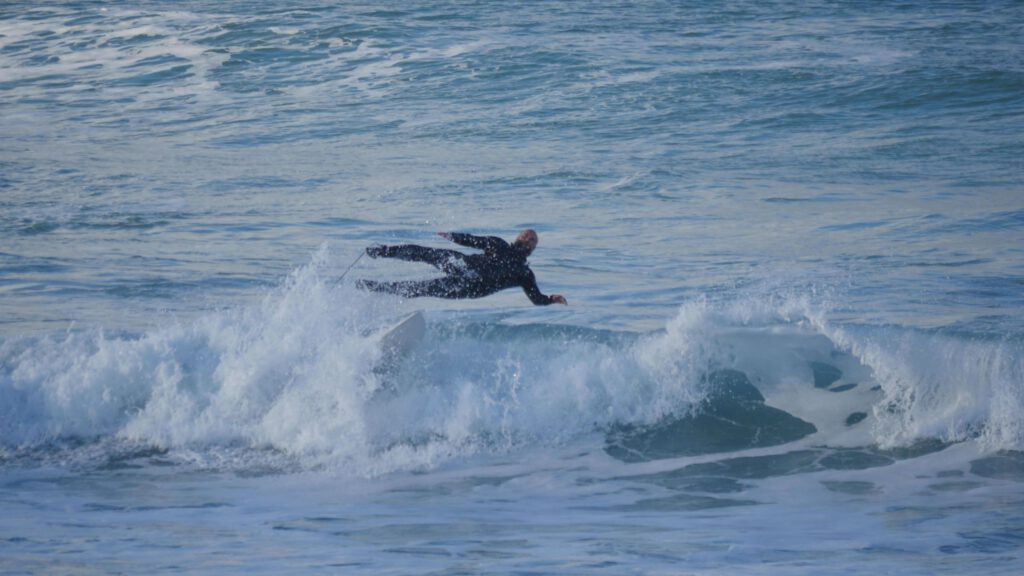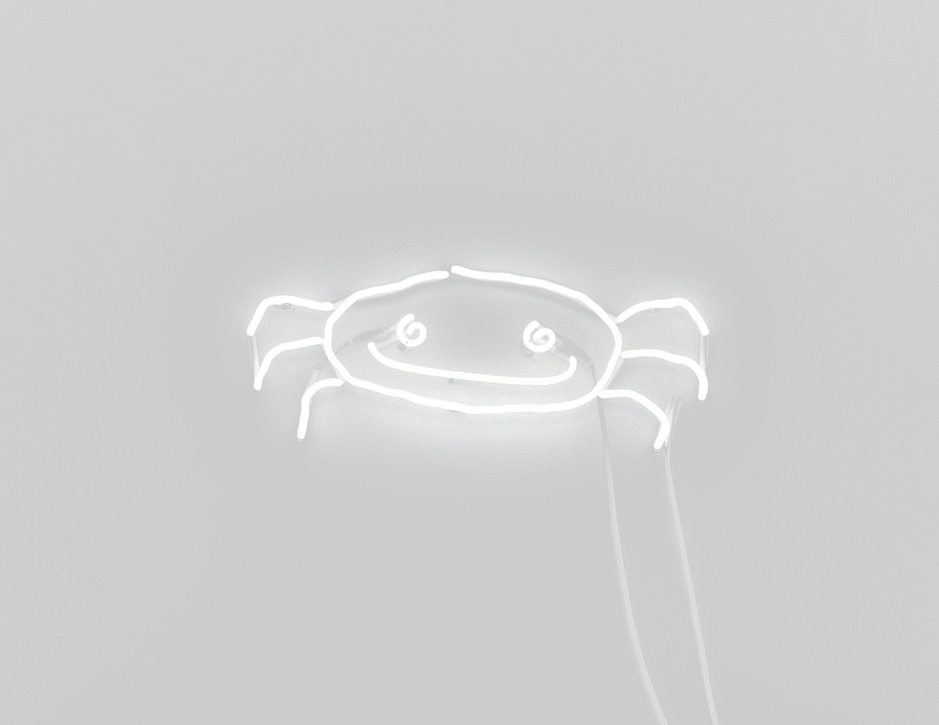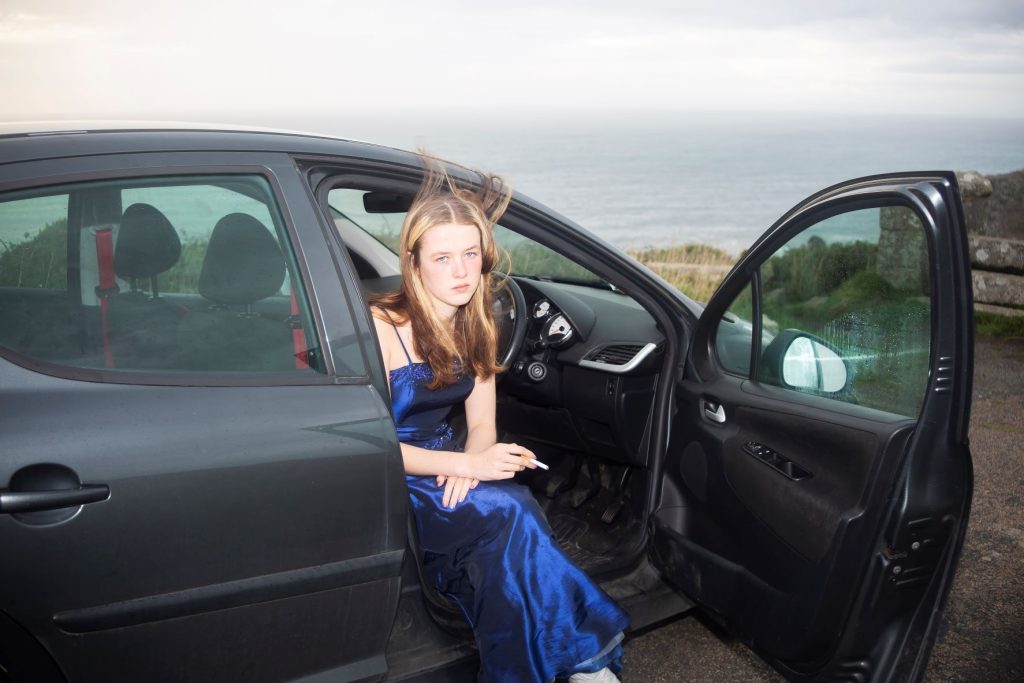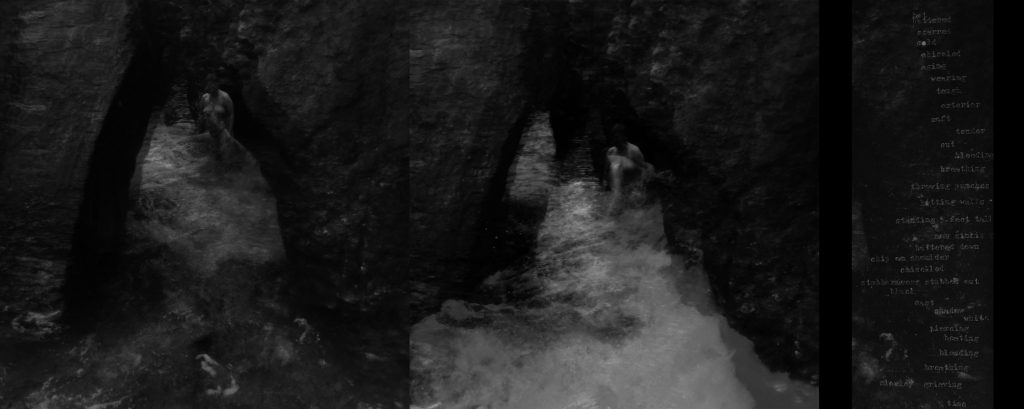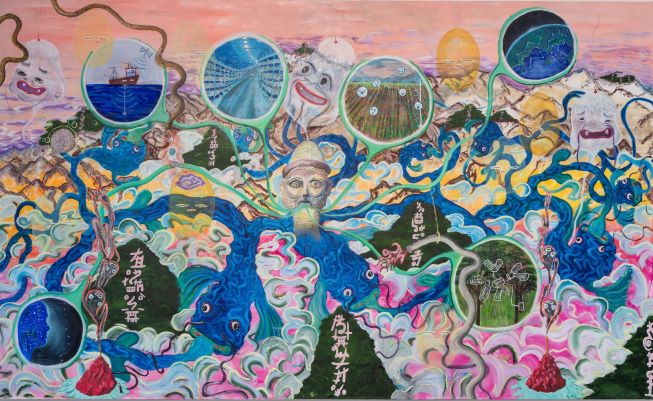Showing at Newlyn Art Gallery
Upper Gallery
Delphi Baker’s work is inspired by the resourcefulness of Ernest Shackleton and the crew of the Endurance, which played a crucial role in their survival. The coracle uses recycled fabric scraps stitched into cords and formed into a vessel. The bitumen waterproofing was used for Kuphar boats in ancient Mesopotamia. The Voyage was created at Tregye, Truro College, and Delphi Baker is currently studying at Central St Martins, London.
Livvy Eden’s series of lumen prints and chemigrams are created with seaweed, flora, and other found materials on the coast, using seawater to naturally fix the images. Through these processes, Eden explores a sense of self-location, connection to the sea and belonging to her environment. Livvy Eden is a photography student, studying and living in Falmouth.
Christopher P. Green’s neon works begin as miniscule drawings made in the corners and margins of waste paper. Crabs are a recurring subject; lone nomads, they dance from side to side rather than moving forwards in linear fashion. Portraying a symbol of independence, they carry their own homes and are highly adaptable to different environments and climates. Christopher P. Green works from a studio at CAST, Helston.
Anna Harris presents a vitrine of tangled forms that are a mixture of found and made objects. Gathered materials have been ground down, mixed together, and fired at extreme temperatures to create strange new geologic artefacts. Anna Harris works from a studio in a quarry at Mabe Burnthouse, near Penryn.
Alastair and Fleur Mackie’s Mount’s Bay Stool is made from a tree that died 2,500 years before Christ was born, at a time when the Great Pyramid of Giza and the standing stones of Stonehenge were being constructed. The oak lived in Mount’s Bay at a time when the bay was wooded and far from the sea. It was pickled in peat, buried under sand, and submerged by the rising Atlantic Ocean for 4,500 years, until uncovered by a winter storm in 2020. Alastair and Fleur Mackie work from a studio in North Cornwall.
Teän Roberts’ large-scale Blue Moon photographs depict a solitary, unearthly being who exists outside of space and time. Curious about thresholds, membranes, and in-between places, Teän uses photography as a portal to climb into transcendental, hard-to-imagine spaces, to reach worlds beyond this one, and to explore alternative modes of existing. Based on the Isles of Scilly, Teän is currently studying an MA at the Royal College of Art in London.
Tanoa Sasraku’s work is from a series of sculptural hybrids, Terratypes. Torbay red ochre is hand-rubbed into sheets of blank newsprint, which are sewn, soaked in Plymouth Sound seawater, and ripped, revealing past layers of pigment and pattern; the intersection of geological time and personal memory. Born in Plymouth, Tanoa Sasraku is currently enrolled at Royal Academy School.
SHARP ‘s Corroding Towards Dusk is a series of photographic works from a performance for camera filmed at Godrevy Point at the far eastern edge of St Ives Bay. The works incorporate the external forces of the sea and the erosion of layers of the artist’s butch/masc identity in relation to ageing. SHARP is a studio member of Krowji, Redruth.
Eleanor Turnbull’s series of work is made on repeat visits to Rinsey Cove, between Praa Sands and Porthleven. Through a series of shrinking moulds, the same rockpool is cast at different scales, including the bowl of a silver spoon. Eleanor Turnbull works between London and Cornwall, and has recently completed an MFA Fine Art at Slade School of Fine Art.
Huhtamaki Wab’s large-scale painting features a mythical giant catfish called the Namazu. After an earthquake devastated Edo in 1855, the Namazu became a symbol of good fortune and with Edo’s reconstruction a symbol for renewal. At a time in which society lives with a constant threat of ecological collapse, the concept of ‘world renewal’ is increasingly present. Huhtamaki Wab works from a studio on the Rame Peninsula.
Lower Gallery

Fran Rowse, Cornish artist and curator, has initiated an exhibition that welcomes female artists from across Cornish coastal towns to be part of a space that encompasses and celebrates Cornish womanhood and unapologetic femininity.
Using her Cornish roots, Fran offers a window into the lives of women in Cornwall. The Lower Gallery will present works by artists that have faced the reality of marginalised female communities, gender identities and Cornish culture.
The artworks share the space with archival images of mothers, pageant queens and working women, visually bridging the gap between modern Cornish maids and their historical counterparts – helping women find and reclaim their space, heritage and culture in our coastal region.
Thank you to No Divide Piercing & Tattoo Studio for the piercings at the opening event.
Many of the works in Cornish Maids are for sale.
Maids Price list
Showing at The Exchange
Simon Bayliss’ lidded jars, made on the potter’s wheel, are based on lighthouses found in the paintings of Alfred Wallis, but also reference the giant sculptural versions in Simon Fujiwara’s solo exhibition at Tate St Ives in 2012. Bayliss upholds the sentiment he witnessed in Fujiwara’s work – to queer the legacy of art history in St Ives – yet his departure is more domestic, both in scale and functionality. Simon Bayliss works from Porthmeor Studios in St Ives.
Naomi Frears’ projected film Men Falling observes surfers as they come to the end of their ride on a wave. In these final moments they seem to give themselves to the sea, each bringing their own particular style to the dismount. This is paired with a second section that recounts the artist’s memories of the days leading up to the death of her father. Naomi Frears works from Porthmeor Studios, St Ives.
Bryony Gillard’s film Unctuous Between Fingers takes as its starting point, an archive at Royal Albert Memorial Museum, Exeter, of pressed seaweeds, collected predominantly by women in the mid 1800s. Through a process of archival research and workshops with enthusiasts, artists, scientists, and philosophers, the film explores seaweeds relationship to contemporary ideas and conversations. Brought up in Penzance, Bryony Gillard is based in Bristol.
Kitty Hillier’s biomorphic forms are distilled, overlapped, and reconstructed in various media. They are rooted in her belief that fundamentally all things are connected, observed from both above and below the surface. They are structures that we can all relate to as essentially ‘natural’, but simultaneously find hard to pin down or identify. Kitty Hillier works from a wharf side studio in Penryn.
Ro Robertson’s drawings are part of an ongoing exploration of the terrain of the Queer body in the landscape. They demonstrate the full-body experience of existing within the sea’s constant reshaping of the land. Intertwined forms and expanded figures bleed into each other via watery channels that provide an alternative view of underground and unseen worlds. Ro Robertson lives in Newlyn, with a studio in Redruth.
Melanie Stidolph’s photographic and video work is influenced by her experience of being childless not by choice. She is drawn to rock pools and mis-using photographic equipment. The photo book Endless Reproduction, photo series Last Summer and video Early Light find a poetic language for her experience, charting a route from grief to glimmers of joy. Melanie Stidolph lives in Hayle.
Melanie is looking for ten particpants to take part in a filmed event at Treyarnon Bay, near Padstow, where a group of women will sing into the dusk and with the dawn, in mid-April. There will be two workshops ahead of the event, Find out more here.
Mary Trapp’s sculptural practice explores slippages between body and space; mopping up ideas of porosity, identity, emergence, and care. Using blown glass, fabric, latex, and shoreline remnants, she forms objects that drip into the space like water hauled bodies. Mary Trapp works from a studio in Falmouth.

